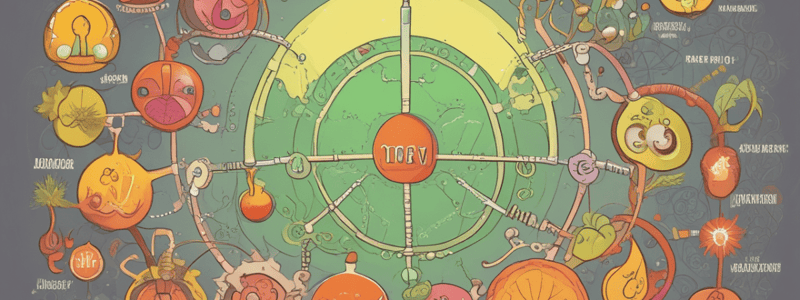Podcast
Questions and Answers
What is the final common pathway for the oxidation of carbohydrate, lipid, and protein?
What is the final common pathway for the oxidation of carbohydrate, lipid, and protein?
- Electron transport chain
- Citric acid cycle (correct)
- Lipogenesis
- Gluconeogenesis
Which of the following is NOT a role of the citric acid cycle?
Which of the following is NOT a role of the citric acid cycle?
- Interconversion of amino acids
- Reduction of coenzymes
- Oxidation of acetyl-CoA
- Formation of ATP through anaerobic glycolysis (correct)
What is the byproduct of the oxidation of the acetyl moiety of acetyl-CoA in the citric acid cycle?
What is the byproduct of the oxidation of the acetyl moiety of acetyl-CoA in the citric acid cycle?
- CO2 and ATP
- Fatty acids and ATP
- CO2 and reduced coenzymes (correct)
- Glucose and ATP
Which tissue is the only one in which all the processes of the citric acid cycle occur to a significant extent?
Which tissue is the only one in which all the processes of the citric acid cycle occur to a significant extent?
How many molecules of ATP are generated per molecule of glucose by anaerobic glycolysis?
How many molecules of ATP are generated per molecule of glucose by anaerobic glycolysis?
What is the energy yield per acetate unit in the citric acid cycle?
What is the energy yield per acetate unit in the citric acid cycle?
What is the role of molecular oxygen in the citric acid cycle?
What is the role of molecular oxygen in the citric acid cycle?
What is the first step in the citric acid cycle?
What is the first step in the citric acid cycle?
What is the intermediate that is oxidized to CO2 and reduces coenzymes in the citric acid cycle?
What is the intermediate that is oxidized to CO2 and reduces coenzymes in the citric acid cycle?
Which of the following processes is NOT a role of the citric acid cycle?
Which of the following processes is NOT a role of the citric acid cycle?
Study Notes
The Citric Acid Cycle (Krebs Cycle or TCA)
- The citric acid cycle is a sequence of reactions in mitochondria that oxidizes the acetyl moiety of acetyl-CoA to CO2 and reduces coenzymes.
- The cycle is linked to the formation of ATP through the electron transport chain.
Role in Cellular Respiration
- The citric acid cycle is the final common pathway for the oxidation of carbohydrate, lipid, and protein.
- Glucose, fatty acids, and most amino acids are metabolized to acetyl-CoA or intermediates of the cycle.
Cellular Processes
- The citric acid cycle has a central role in gluconeogenesis, lipogenesis, and interconversion of amino acids.
- These processes occur in most tissues, but the liver is the only tissue in which all occur to a significant extent.
Steps of the Citric Acid Cycle
-
- Synthesis of citrate from acetyl-CoA and oxaloacetate
-
- Isomerization of citrate
-
- Oxidation and decarboxylation of isocitrate
-
- Oxidative decarboxylation of α-ketoglutarate
-
- Cleavage of succinyl-CoA
-
- Oxidation of succinate
-
- Hydration of fumarate
-
- Oxidation of malate
Energy Yield
- 1 acetate unit generates approximately 12 molecules of ATP per turn of the cycle.
- In contrast, anaerobic glycolysis generates only 2 molecules of ATP per molecule of glucose (which generates 2 molecules of acetyl-CoA).
- Molecular oxygen does not participate directly in the citric acid cycle.
Studying That Suits You
Use AI to generate personalized quizzes and flashcards to suit your learning preferences.
Related Documents
Description
The citric acid cycle, also known as the Krebs or tricarboxylic acid cycle, is a sequence of reactions in mitochondria that oxidizes the acetyl moiety of acetyl-CoA to CO2. It's a critical step in cellular respiration, providing substrates for the respiratory chain.




